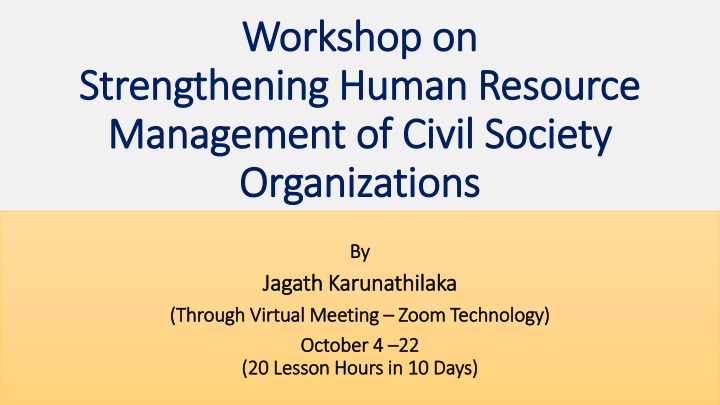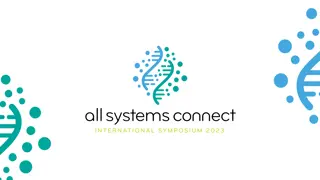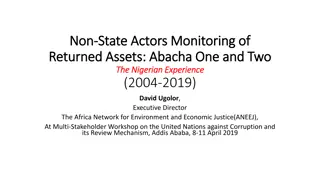
Strengthening Human Resource Management of Civil Society Organizations Workshop
This workshop by Jagath Karunathilaka focuses on various topics related to human resource management in civil society organizations. Covering areas such as recruitment, rewards, performance review, and current HR trends, participants will gain valuable insights and practical tools to enhance HR practices in their organizations.
Download Presentation

Please find below an Image/Link to download the presentation.
The content on the website is provided AS IS for your information and personal use only. It may not be sold, licensed, or shared on other websites without obtaining consent from the author. If you encounter any issues during the download, it is possible that the publisher has removed the file from their server.
You are allowed to download the files provided on this website for personal or commercial use, subject to the condition that they are used lawfully. All files are the property of their respective owners.
The content on the website is provided AS IS for your information and personal use only. It may not be sold, licensed, or shared on other websites without obtaining consent from the author.
E N D
Presentation Transcript
Workshop on Workshop on Strengthening Human Resource Strengthening Human Resource Management of Civil Society Management of Civil Society Organizations Organizations By By Jagath Jagath Karunathilaka Karunathilaka (Through Virtual Meeting (Through Virtual Meeting Zoom Technology) October 4 October 4 22 22 (20 Lesson Hours in 10 Days) (20 Lesson Hours in 10 Days) Zoom Technology)
Lesson Plans of HR Management of CSO Lesson Plans of HR Management of CSO Chapter No Lesson Topics Scheduled Date Timing Monday, 4th October 1 Business Code Practice, Compliance and Data Security Employment Practices 10.00 12.00am 2 Tuesday, 5th October 3 Recruitment, Selection and Induction 10.00 11.30am Wednesday, 6th October 4 General Terms and Conditions of Employment 10.00 12.00am Thursday, 7th October 5 Rewards and Recognition 10.00 11.30am Monday, 11th October 6 Performance Review, Training & Learning Practices Superannuation and Severance 9.00 12.00am Tuesday, 12th October 7 10.00 11.30am Wednesday, 13th October Thursday, 14th October 8 Conflict and Grievance Management 10.00 11.30am 9 Disciplinary Management 9.00 12.00am Thursday, 21st October 10 Employment Law & Employee Rights 10.00 12.00am Friday, 22nd October 11 Current Issues & Trends in HRM 10.00 11.30am
Chapter Chapter 11: Current Issues & Trends in HRM 11: Current Issues & Trends in HRM About About This Chapter This Chapter The current issues and trends in HRM chapter of this workshop is designed, you to learn about the significant concerns facing human resource management in your organizations. The guidance and the tools introduced through this chapter can help you to address forthcoming HR issues more effectively
Current Current Issues & Trends in HRM Issues & Trends in HRM Topic Topic Content Covered Content Covered Ability and disability diversity in the workplace Age diversity in the workplace: different types of ages within a business environment and how adjust to an aging population in various ways Gender diversity in the workplace: gender diversity deals with equal representation of men and women in the workplace Cultural diversity in the workplace: cultural diversity is a form of appreciating the differences in individuals. The differences can be based on gender, age, sex, ethnicity, sexual orientation, and social status. Organizations have realized the value in acquiring a diverse workforce. Workplace violence: violence in the workplace and steps that HR can take to reduce it Work Place Diversity
Current Current Issues & Trends in HRM Issues & Trends in HRM Topic Topic Content Covered Content Covered Pros and cons of alternative work arrangement: home office, virtual teams and telecommunicating : virtual team, flexibility, drawbacks HR challenges in managing global pandemic: study the element of a global pandemic situation with analysis of its course and effect and define strategies to overcome HR challenges Human resource information systems: costs and benefits to employee, HR and organizations how heading to a 'paperless' office, the amount of information handled by HR professionals seems to keep growing Alternative Work Arrangements : HR Challenges in Managing Global Pandemic Human Resource Information Systems
What is diversity in the workplace? What do we mean by diversity in the workplace? Diversity in the workplace refers to an organization that intentionally employs a workforce comprised of individuals with a range of characteristics, such as gender, religion, race, age, ethnicity, sexual orientation, education, and other attributes.
What is workplace diversity and why is it important? Diversity in the workplace means the acceptance and inclusion of employees of all backgrounds. A diverse workplace is an important asset, since it acknowledges the individual strengths of each employee and the potential they bring.
What is workplace diversity and why is it important? Diversity in the workplace means the acceptance and inclusion of employees of all backgrounds. A diverse workplace is an important asset, since it acknowledges the individual strengths of each employee and the potential they bring.
What is workplace diversity and what does it focus on? Diversity focuses on the demographics of your workplace (gender, race, age, professional background, sexual orientation, etc.), while inclusion focuses on efforts towards helping employees- with all of those different aforementioned traits (plus thousands of more)- feel safe, happy and respected.
What are the 5 key areas of diversity? What are the types of diversity? Cultural diversity. Racial diversity. Religious diversity. Age diversity. Sex / Gender diversity. Sexual orientation. Disability.
Which is the best example of diversity at the workplace? Answer: Diversity at work can be portrait in different scenarios. Counting on people from different ages and ethnicity or allowing people with disabilities to be part of the work frame is one example.
How do you understand diversity? It means understanding that each individual is unique, and recognizing our individual differences. These can be along the dimensions of race, ethnicity, gender, sexual orientation, socio- economic status, age, physical abilities, religious beliefs, political beliefs, or other ideologies.
Why is it important to value diversity? It is important to value diversity because: people build a stronger sense of identity and wellbeing, and have better education and career outcomes when their diverse strengths, abilities, interests and perspectives are understood and supported.
How can HR prevent workplace violence? In addition, offer training on steps workers can take to protect themselves, like avoiding being alone when working after hours and letting security know when they leave. Follow Reporting Procedures: Make sure your security outlines reporting procedures when employees are in immediate danger.
Here are seven steps to take to make sure your workplace violent prevention training is effective: Analyze your workplace. Create a supportive environment. Offer communication and empathy training. Establish a clear workplace violence policy. Commit to a non-violent workplace. Train employees to recognize warning signs.
What is workplace violence examples? What can workplace violence or aggression look like? physical assault such as biting, scratching, hitting, kicking, pushing, grabbing, throwing objects. intentionally coughing or spitting on someone. sexual assault or any other form of indecent physical contact.
What are the 4 types of workplace violence? Types of Workplace Violence Type 1: Criminal Intent. ... Type 2: Customer/Client. ... Type 3: Worker-on-Worker. ... Type 4: Personal Relationship.
Common examples of employee harassment in the workplace Sexual and gender employee harassment. ... Racial harassment. ... Harassment related to religious beliefs. ... Employee harassment related to sexual orientation. ... Ageism in the workplace.
Prohibition Prohibition of Harassment of Harassment Employees have the right to work in an environment that is free from demoralizing effects of intimidation and harassment. Abuse or corporal punishment in any form and verbal or physical conduct by any employee that harasses another or disrupts another s work performance or creates an intimidating, insulting, offensive, abusive, or hostile work environment is not tolerated. Unwelcome sexual advances, requests for sexual favors, and other unwelcome verbal or physical conduct of a sexual or offensive nature are considered sexual harassment and are specifically prohibited.
Prohibition Prohibition of of Harassment Harassment Examples Examples of sexual harassment include: unwelcome verbal behavior such as derogatory, offensive comments, suggestions, jokes, or remarks; unwelcome and inappropriate physical behavior such as pats, squeezes, deliberately brushing against someone s body, or impeding or blocking normal work or movement; unwanted sexual advances; unwelcome and inappropriate visual harassment such as displaying derogatory, sexually suggestive, or discriminatory messages, photos, graffiti, pictures, cartoons, or drawings, at one s work station; unwanted or offensive e-mail or voicemail messages. The behavior need not be intentional in order to be considered sexual harassment.
Prohibition Prohibition of of Harassment Harassment In the instance of a violation of the policy, the complaint should be directed to the HR division in writing of the extent and nature of the discrimination for timely resolution and disciplinary action. All reported incidents will be investigated with an effort to keep the source of the report confidential except where disclosure necessary for resolution. Any employee who, in good faith, reports a possible violation of this policy will be protected from any form of retaliation (See Harassment or Abuse Reporting Form).
Alternative Work Arrangements : HR Challenges in Managing Global Pandemic
Alternative work arrangement: home office, virtual teams and telecommunicating : virtual team, flexibility, drawbacks What is Virtual Team? A virtual team can be defined as a team of people which can be working in the same office or spread across various locations- which can be different cities, countries and hence different time zones too. People of varied cultures, backgrounds, and expertise come together to work on a common goal.
Advantages and Disadvantages of Virtual Teams: Advantages or Benefits of Virtual Teams Disadvantages of Virtual Team Problems arising out of technological issues Communication gaps Less team bonding Less cohesiveness Saves Resources Wide Availability of talent Low attrition rate Avoids wastage of time Reduces cost of travelling Uneven distribution of knowledge Increased productivity Difference of speed and timing Uncertainty about the meaning of silence 24*7 work possible
Alternative work arrangement: home office, virtual teams and telecommunicating : virtual team, flexibility, drawbacks What telecommuting meaning? Work at home by the use of an electronic linkup with a central office.
Image result for telecommuting What is an example of telecommuting? Telecommuting is an employment arrangement in which the employee works outside of the employer's office. Often this means working from home or at a location close to home, such as a coffee shop, library, or co-working space
Image result for telecommuting Alternative work arrangements involve providing flexibility in how people engage in work activities and how companies utilize labor. Alternative work arrangements include flexibility in: Hours Locations Workspace Number of employees in workforce depending on current needs Employee skills and abilities
Virtual Teams Virtual Teams Pros and Cons: Pros and Cons: All All You Need to You Need to Know Know
Virtual Teams Pros and Cons (The PROS) Happier Employees This is one of the biggest benefits of a virtual team. When you re working remotely as an employee, you have the flexibility to balance work/ life tasks that are otherwise harder to manage around. You don t need to take a day off of work for a dentist appointment or a child s teacher meeting; you just work around those personal tasks.
Virtual Teams Pros and Cons (The PROS) More productive employees Happier employees produce more, which means employers get more out of their employees.
Virtual Teams Pros and Cons (The PROS) Cost Savings Employers also save on real estate costs, which means more money in the bank. They don t have to worry about office space, travelling or leasing new facilities as their team grows. Even if a team is not entirely virtual, having a partial remote This makes an organization more competitive because it can use those savings for more strategic initiatives.
Virtual Teams Pros and Cons (The PROS) Bigger Talent Pool & Extended Hour Coverage When a company builds a virtual workforce, the talent pool opens up to candidates all around the world. Employers are no longer restricted to hiring in their own geographic region, and don t have to worry about relocating people. This gives them access to a much bigger skillset at a fraction of the cost. An added bonus is that they get to strategically hire resources in other countries to have extended time coverage on business hours (including a 24-hour cycle for functions such as customer service.)
Virtual Teams Pros and Cons (The PROS) Lower Carbon Footprint Employers also use less office space, which means lower usage of heating, cooling, water, and electricity utilities as well. All of that reduces the carbon footprint and contributes positively to the environment.
Virtual teams Pros and Cons (The CONS) The Trust Factor A top issue that managers have about virtual teams is whether they can trust that their employees do the job they re supposed to do. This is a valid concern. If managers can t see what their employees are doing, then how can they trust that their employees are not wasting time on personal tasks?
Virtual teams Pros and Cons (The CONS) Reduced Team Collaboration Another issue is the lack of team collaboration. Virtual teams can be very transactional by nature where everyone is off doing their own job in their separate silo. Some teams feel that the lack of face-to-face interaction in virtual environments adds to the problem of communicating or collaborating effectively. That s because they miss out on reading subtle cues such as facial expressions and body language signs by their team members.
Virtual teams Pros and Cons (The CONS) Social Isolation Virtual teams can feel very lonely, which leads to social isolation of team members.
Virtual Teams Pros and Cons (Conclusion) However, I do understand that virtual teams are not for everyone, and that there are certain industries or situations where focusing on a non-virtual model could make more sense.
What is meant by human resource information system? A human resource information system (HRIS) is software that provides a centralized repository of employee master data that the human resource management (HRM) group needs for completing core human resource (core HR) processes. ... In some ways, an HRIS can be considered a smart database of employee information.
What are the key functions of a human resources information system? HRIS solutions feature data entry, data tracking, data analysis, and information-related capabilities to address a wide range of human resources department needs, including applicant tracking, onboarding, payroll, performance management and accounting functions.
What is the role of information technology in human resource management? By focusing on using technology to continuously improve the quality of the work. Technology can improve the information available to HR, facilitating HR processes, and making them faster and more effective. One of the biggest allies in HRM, HRIS is adopted to make organizations more accurate and effective.
What are HRIS applications? HRIS (human resources information system) is a type of business application that enables companies to store employee information, manage common HR functions, and execute critical HR activities such as processing payroll and administering benefits
What is an example of HRIS? Examples of HRIS systems include: Applicant tracking systems (ATS) to help the hiring process. HCM (human capital management) ... Payroll management tools for compensation management.






















